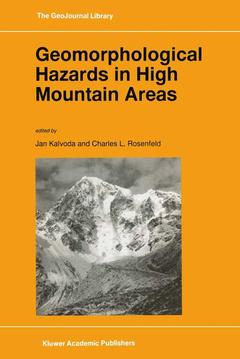Description
Geomorphological Hazards in High Mountain Areas, Softcover reprint of the original 1st ed. 1998
GeoJournal Library Series, Vol. 46
Coordinators: Kalvoda J., Rosenfeld C.L.
Language: English
Subjects for Geomorphological Hazards in High Mountain Areas:
Keywords
Publication date: 10-2012
316 p. · 16x24 cm · Paperback
316 p. · 16x24 cm · Paperback
Description
/li>Contents
/li>Comment
/li>
On the basis of a total of thirteen case examples from the Tien Shan, Karakorum, Himalaya and Tangula Shan (central Tibet), the risk potential and hazards are inferred from the development of landscape during the Quaternary. The history of glaciers can be seen as of central importance for this. The Ice Age glacial erosion created V-shaped valleys, which with their steep flanks - as a consequence of the interglacial formation of V -valleys - have prepared and brought about landslides as well as rockslides and the hazards, combined with them. The same is true for the moraines, which the gla ciers have deposited high-up in the valley flanks and related loose stone deposits. Dry and wet mass movements follow after heavy precipitation, especially in the semi-arid investigation areas, and are catastrophes for the settlements and the communication routes in the valley floors. Their key-forms are debris cones and debris slopes, as well as mudflows and alluvial fans. In addition to the Ice Age glaciation history, as a preparatory, indirect factor, the Holocene to present glaciation history is, as a result of the danlming-up of glacier- and moraine lakes and their outbursts, a direct risk factor. The examples presented of acute and already occurred cases of damage were inves tigated in the years 1989-1994. Acknowledgements The authors wish to thank the Deutsche Forschungsgemeinschaft (DFG), the Max Planck-Gesellschaft (MPG), the Volkswagen-Stiftting (VW) and the Deutscher Aka demischer Austauschdienst (DAAD) for the financial support for the field-work.
Sedimentology and clast orientation of deposits produced by glacial-lake outbursts floods in the Mount Everest region, Nepal.- Catastrophic flood flushing of sediment, western Himalaya, Pakistan.- Landslides and deserted places in the semi-arid environment of the Inner Himalaya.- Glacier-induced hazards as a consequence of glacigenic mountain landscape, in particular glacier- and moraine dammed lake outbursts and holocene debris production.- Chaos theory of slides/mud flows in mountain areas. Example: Xiaojiang Basin, NE Yunnan, China.- The salt weathering hazard in deserts.- Impact of conversion of upland forest to tourism and agricultural land uses in the Gunung Kinabalu Highlands, Sabah, Malaysia.- Landslides in the Rocky Mountains of Canada.- Late Holocene sturzstroms in Glacier National Park, Montana, U.S.A..- Storm induced mass-wasting in the Oregon Coast Range, U.S.A..- Natural hazards in relation to present stratovolcano deglaciation: Popocatepetl and Citlatepetl, Mexico.- Andean landslide hazards.- Fluvial hazards in a steepland mountain environment, southern Bolivia.- Geomorphological response of neotectonic activity along the Cordillera Bianca fault zone, Peru.- Geomorphological hazards and risks in the High Tatra Mountains.- Geomorphologic hazards in a glaciated granitic massif: Sierra de Gredos, Spain.
This volume presents a collection of papers by specialists contributing to the activities of the International Geographical Union Commission on `Natural Hazard Studies'. The main topics are : morphotectonic activities, slope movements, glacial, erosion and weathering hazards and man-made rapid modellation processes. Research on basic geomorphological hazards in high mountains can be understood not only as a set of case studies, but primarily as a rare opportunity for the preparation of theoretical models and for the understanding of the general architecture of the origin of natural disasters. Audience: This specialized book will be useful for natural scientists, graduate geographers and geologists and postgraduate students in earth sciences.
© 2024 LAVOISIER S.A.S.




